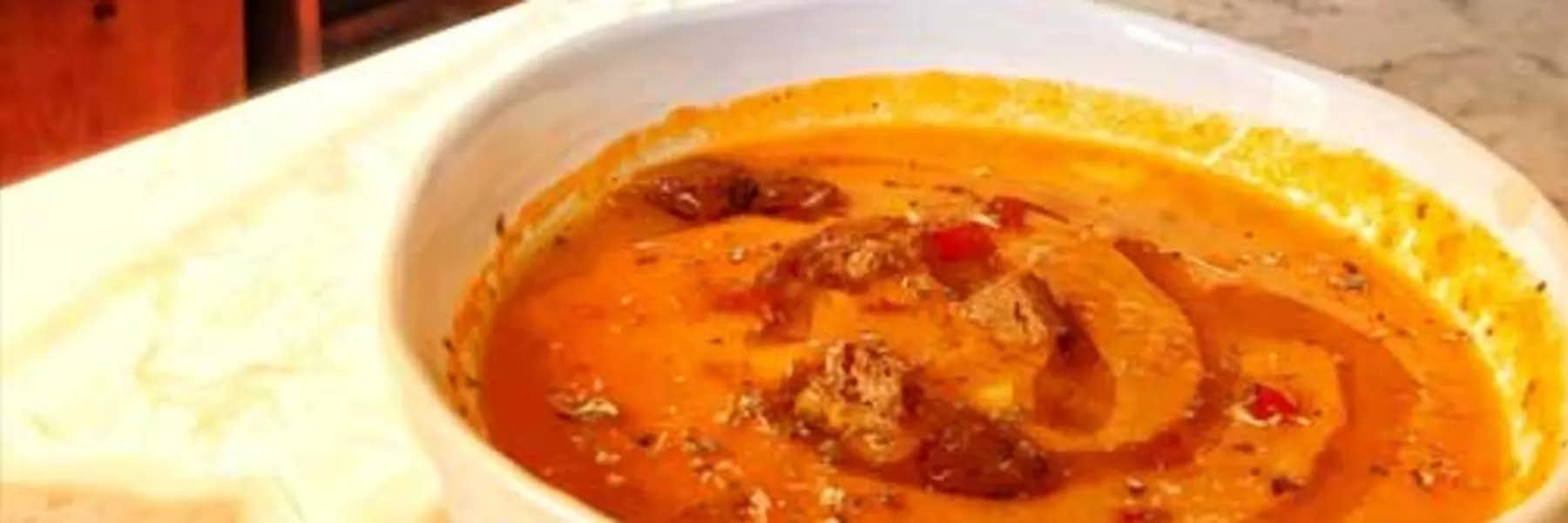I landed in Portugal for the first time just before 9 a.m., the 12th of February 2019. I was 53 years old. With any luck, you'll learn from my mistake.
I've been traveling internationally since I was about 7 years old. I've seen a lot of places across six continents and 64 countries. For years, Portugal had been on my list of countries to visit, shoved somewhere between a variety of other countries I'd like to see some day if I get around to it. But it wasn't a must-see destination. It wasn't, say, Oman or Bhutan. Or Saint Petersburg, Russia. Or Scotland. Or Laos. Or even Iran. It was Portugal—Spain light. I'd been to Barcelona (many times) and Madrid. Would Lisbon and Porto really be so different?
Again, please: Do not follow in these unwise, unknowing footsteps. Go. See Portugal. This is a country that should be atop every travel bucket list.
I won't tell you all the ways that Lisbon and Porto wooed me. That's a different travelogue. Instead, I will feed your hunger with the story of food. Very. Very. Good. Food.
When people learn the extent of my passport stamps, the person I'm talking to at that particular moment will invariably want to know, "What's the best food?"
Let me say here that I once asked a cabbie in London where I could find the best vindaloo. He told me "that's like asking, 'Who's more attractive—blondes, brunettes or gingers.'" Same with world cuisine, really. But here's the answer I give, though I'm not saying I'm right: Singapore has the best street food, bar none. South Louisiana, where I grew up, has the planet's best seafood (the rest of the Creole / Cajun cuisine is primo, too). And Spanish tapas—with a glass or three of proper sangria—probably gets my vote for best food ever.
And now comes Portugal to throw at me petiscos—the local take on tapas. I won't go so far as to say petiscos are better than tapas. But I will say they are, for me, tapas-adjacent.
I spent my days in Lisbon purposefully hunting petiscos for nearly every lunch and dinner. (In Porto, I was all about the sandwiches, but, again, a different travel story.)
Like I said, I landed in Portugal, in Lisbon, just after 9 a.m. Just after 1 p.m. I'd finished wandering the St. George Castle, high up on one of the seven hills that ring Lisbon. I was hungry and went looking for lunch.
Just a few yards outside the castle gate, I turned onto a narrow, cobblestone side-street that showed little promise—until I noticed a small wooden placard hanging from a wrought iron bracket and engraved with the word petisqueira. Without trying—or Googling—I'd accidentally happened upon my first petiscos joint: Petisqueira Conqvistador.
Petisqueira Conqvistador
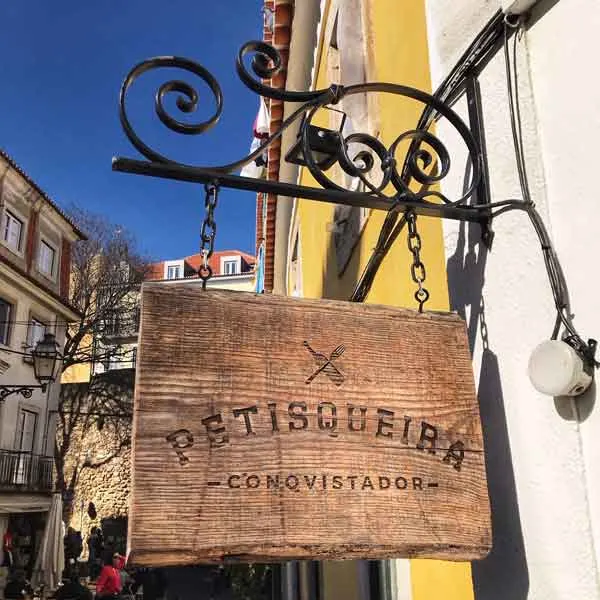
I stepped into a small, bright space of white plaster walls and terracotta tile floors. Nine, simple wooden tables with marble tops and simple wooden benches offered seating for a cumulative 21 diners. A foursome of young locals had claimed a pair of tables. Nearby sat an elderly couple clearly from the surrounding neighborhood, based on their jovial interaction with, and hugs from the waitress.
I took a seat in front of the window. The waitress dropped off the one-page, laminated menu and a tin basket of rustic bread and cornbread, as well as two small mason jars of olives and marinated carrot slices. I sat there for a moment, warmed by the sun on my back, experiencing a moment of complete contentment. This is exactly what I look for when I’m traveling—an unpretentious eatery where the locals hang out; a simple, down-to-earth menu; in a setting that is foreign yet comforting.
Petiscos, I should note quickly, are small dishes—except when they’re not. Sometimes each dish is just a few bites, enough for one person to try several different items. Other times, each dish is made for two or three people to share. Everyone orders a few items, and everyone takes from each other’s order—family style dining, the way meals should be.
Alas, when one is traveling alone, sharing’s not an option. So, I only ordered one to three items at each restaurant I found.
At Petisqueira Conqvistador, I started with the gazpacho, because it’s gazpacho, possibly the greatest soup ever invented. Back in the U.S., you can find versions of this cold, tomato/vegetable soup all year long. In this part of the world, gazpacho tends to be a spring/summer option only. In fact, the waitress turned to yell at the kitchen (literally yell) to make sure they really did have the soup. They did. And it was in the top two or three gazpachos I’ve ever had (the others having found me in Madrid and Barcelona).
I also ordered the punheta de Bacalhau, something like a ceviche/sashimi/carpaccio love-child made from raw salt-cod served cold and marinated in olive oil, red-wine vinegar, garlic, and sweet paprika. If you like the briny, deep fishy flavor of mackerel sushi, you’ll like this. If you like your fish like Casper the Friendly Ghost (there only in form) then you should probably move on. Me, I thought it was quite tasty.
Rounding out my meal: A bowl of rabbit escabeche, a warm concoction of shredded, slow-cooked rabbit, bathing in a vinegar-garlic-onion stew. Think of shredded dark-meat chicken, moist and tender, but with a far sweeter flavor. This is an exceptional dish. I would return just to eat this again.
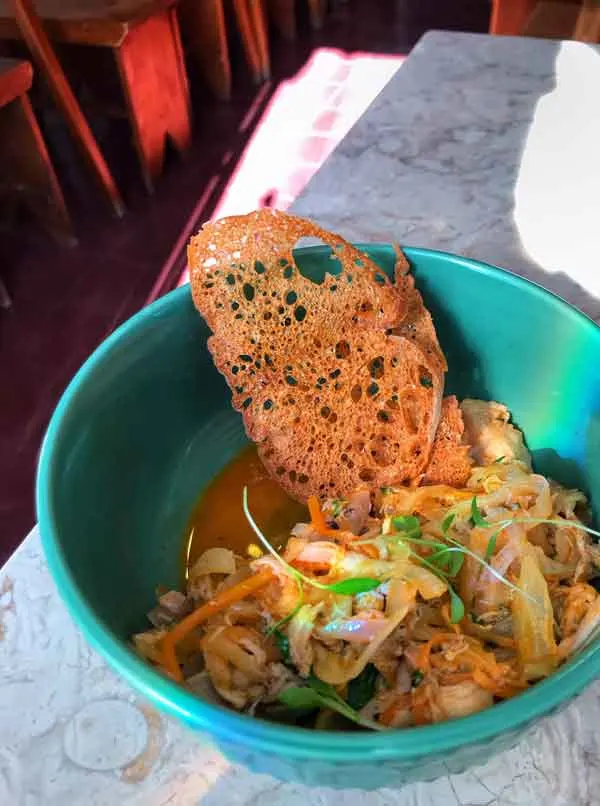
I spent the next 90 minutes of a more-than two-hour lunch writing quietly in my notebook while relishing two glasses of sangria to which Petisqueira Conqvistador adds fresh mint and a cinnamon stick. Really some of the best sangria I’ve had—and I’ve had sangria all over the Latin world.
Taberna da Rua das Flores
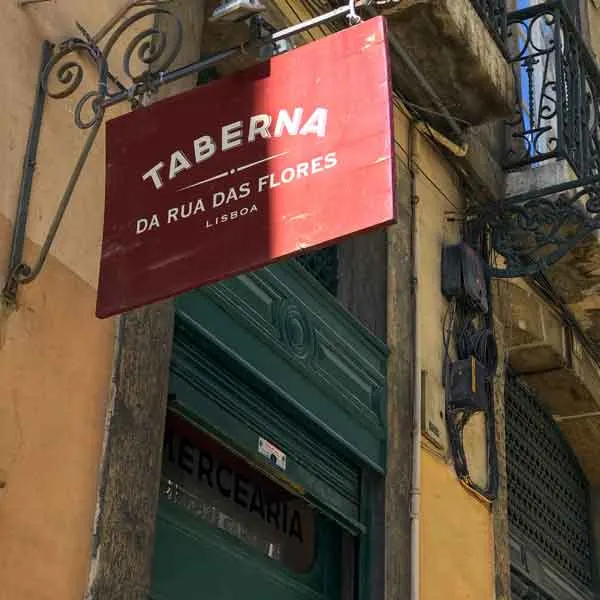
Next stop: Taberna da Rua das Flores. I found this place wandering around on a Friday night after I’d returned from Porto. People were milling about outside and, I noticed, watched with me what I would soon discover was pity when I walked in, looking for a table for one. The hostess ushered me quickly back outside and asked my name.
“I don’t have a Jeff,” she told me, scanning a piece of paper filled with names.
“I don’t have a reservation. Can I put my name on the list?
And, thus, we come to the pity. “Oh, sweetie. No. No, you can’t do that. The wait is already more than two hours.”
“Can I make a reservation for tomorrow night?”
More pity—I saw the smirks on the faces nearby watching this unfold. “Oh, no, sweetie. We don’t take reservations. You just show up. I recommend you get here before six if you want to eat.”
Right.
From my few seconds inside the eatery, I knew what she meant. The space is tiny—just a handful to tables. In fact, I saw a couple of people eating while sitting on a set of stairs.
Not wanting to miss out, I showed up early on Saturday…for lunch. One of the first five people in line for the noon opening.
Turns out it was “pot” day, in which the restaurant only serves one meal to everyone: a terra-cotta pot of beef, still on the bone, cooked with Portuguese sausage, cabbage, turnips, carrots, rutabagas, and red onion. This is a two-person meal, but I was on my own. Which means I did not order the petisco-sized starters I wanted, which includes a sardines’ appetizer served in an oversized sardine can (and which smelled great; the British couple next to me ordered it).
My pot arrived with a basket of rustic bread, a plate of chickpeas, and a bowl of olives. I told the waiter, “That’s a lot of food for one guy.”
“Welcome to Portugal,” he replied.
The “pot” was fine, the beef tender and tasty and the veggies flavorful. But I’m not the biggest fan of gnawing around the gristle that’s generally inherent in a rustic dish of meat cooked on the bone.
However, for me, the lunchtime star was dessert—something called Abade de Priscos.
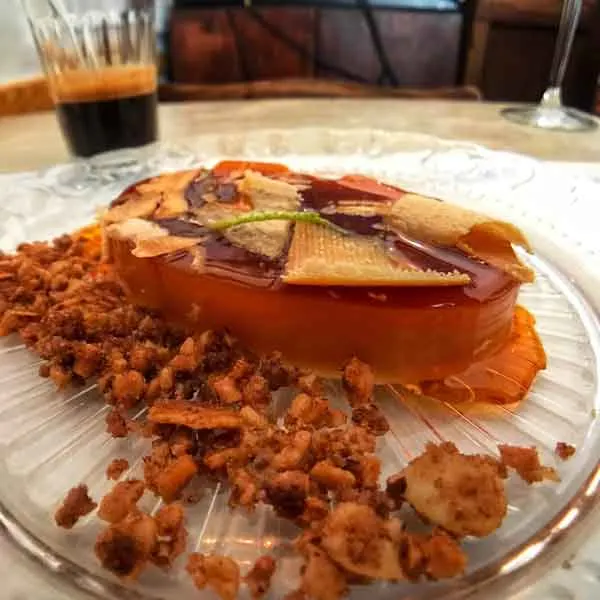
“It’s made from port wine and eggs,” the waiter described. “And pork lard.”
“Pork lard,” I shot back. “As in lard? From a pig? Oink oink?”
He smiled and nodded: “Very Portuguese.”
Of course I had to order it. Travel is nothing if not the opportunity to experience—for better or worse—what other cultures prize the most. And this waiter seemed quite proud of this dessert.
Turns out it’s the consistency of flan, served with chopped nuts and shards of a very musty, hard cheese on top. It’s not overly sweet and has a bit of a tart bite from the cheese. I would order it again, but I will tell you now to go into this dessert with an open mind. It’s not your typical tiramisu or crème brûlée.
Also, if you happen to visit Taberna da Rus das Flores, bring cash. No credit cards accepted here.
Several hours later found me having Saturday dinner at a place I am quite reluctant to name. The thing about travel is that you risk destroying the very experiences you love the most simply by telling other people to go have those experiences, too. By doing so, what you love the most is no longer that same, authentic experience because too many people are there to ruin the view or to force a restaurant owner to cut corners or eliminate the personal hospitality simply because there are too many customers to placate.
And that’s truly how I feel about tiny Taberna do Mar, a local’s-only eatery in the quiet-but-gentrifying Graça neighborhood a few minutes’ walk east of Lisbon’s city center.
Taberna do Mar

This 26-seat restaurant is what happens when petiscos meet Japanese sushi culture. And it’s an exquisite marriage, presided over by the most humble, congenial chef, Filipe, who personally delivers each dish to your table and describes its ingredients and preparation.
The menu is one page with just 16 items, almost all of them between 2.25 and $5.65. But I opted for the most expensive item: A 10-course tasting menu to share with an American expat I was interviewing.
I won’t describe every single dish. But I will tell you every single dish is worthy of description. The grilled-sardine sushi with sea salt… the shot-glass of horse-mackerel soup (fashioned from fish heads and fish bones) … the sliver of bread with sardines and a grilled-sardine sauce… the dried tuna bites in a soy/muscatel wine sauce and left to age for two weeks in the refrigerator… the “dim sum” of mushroom, seaweed and ox tongue… the gray mullet sashimi, with fleur de sal, cured egg yolk and orange and lemon.
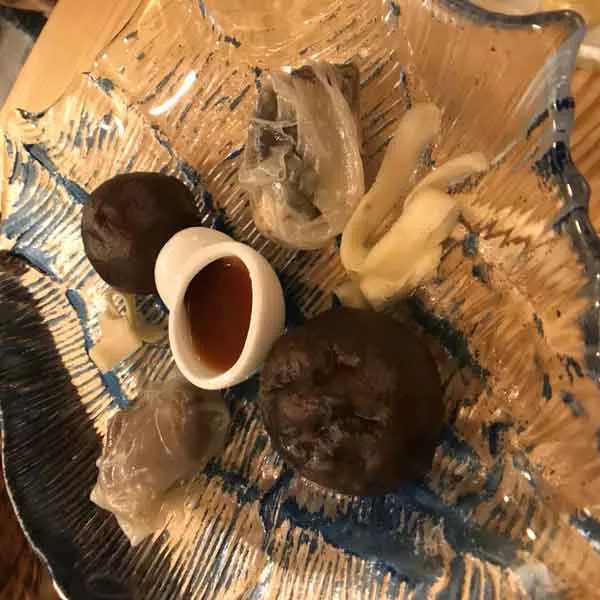
Nothing—not a single thing—would I skip. In fact, I’d go back weekly to have this meal over and over again.
For dessert, opt for the sampler of three. With luck, Chef Filipe will have his sea-fennel crème brûlée on the menu. “It’s something I’m testing out,” he told me. This one definitely passes the test, for me.
Like I said, the tasting-menu was the most expensive offering at Taberna do Mar… all of $28. It’s a ridiculously cheap price for a meal this exceptional. But, again, bring cash. Chef Filipe’s credit-card machine tends not to like foreign credit cards.
Finally, Sunday. Lunch, just before heading to the airport.
I was back on the hill near St. George Castle to take some photos. I passed a restaurant just before noon that was preparing to open for the day. I read the menu the waitress set out on a table and noticed it was a petiscos place. Lucky again, I thought.
São Jorge Restaurante

So, I grabbed a chair outside São Jorge Restaurante for an al fresco midday meal overlooking central Lisbon. As with all the best places, the menu was again limited to a single page. My order: homemade lemonade, tempura green beans with fried baby sardines (a take on fish and chips?), and a (perfectly medium-rare) steak sandwich with “old mustard mayonnaise” on a crusty rustic bun, and homemade potato chips.

I sat there, totally relaxed for two hours, writing and eating good food (and drinking a fantastic, rosemary-scented lemonade) at a languid pace. The only criticism I can offer is that the steak sandwich is so thick that it requires a knife and fork. But, honestly, what kind of criticism is that, really, when something tastes this good?
And with that… I was off to the airport, fully sated on petiscos.
Fact is, Portugal has an abundance of stellar food options, particularly seafood and pork, which in terms of national religion, barely falls below Christianity and soccer in popularity (and maybe that’s too generous to Christianity and soccer). But the petiscos… they’re a primary reason I’m ready to spend a long weekend back in Portugal soon. I just know there are many more petisqueira for me to stumble upon.
I guess what I am saying is this: Go to Portugal. Put it at the top of your bucket list. And the moment you arrive, go find a petisqueira and settle in for some great food and some great local wine and sangria.
View this post on Instagram
A post shared by International Living (@internationalliving) on Mar 7, 2019 at 7:11am PST
Related Articles
Fun and Interesting Facts about Portugal
